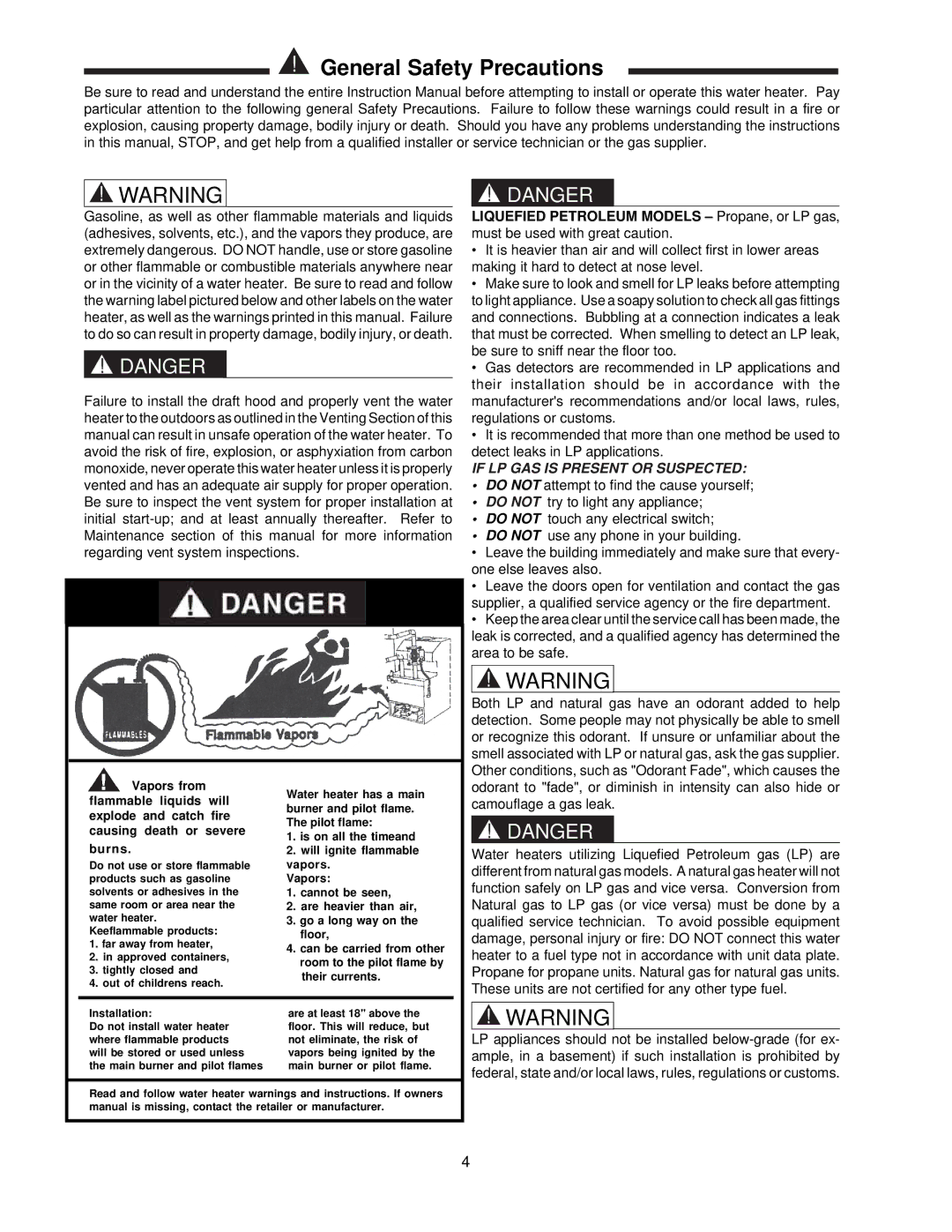
!General Safety Precautions
Be sure to read and understand the entire Instruction Manual before attempting to install or operate this water heater. Pay particular attention to the following general Safety Precautions. Failure to follow these warnings could result in a fire or explosion, causing property damage, bodily injury or death. Should you have any problems understanding the instructions in this manual, STOP, and get help from a qualified installer or service technician or the gas supplier.
!WARNING
Gasoline, as well as other flammable materials and liquids (adhesives, solvents, etc.), and the vapors they produce, are extremely dangerous. DO NOT handle, use or store gasoline or other flammable or combustible materials anywhere near or in the vicinity of a water heater. Be sure to read and follow the warning label pictured below and other labels on the water heater, as well as the warnings printed in this manual. Failure to do so can result in property damage, bodily injury, or death.
!DANGER
Failure to install the draft hood and properly vent the water heater to the outdoors as outlined in the Venting Section of this manual can result in unsafe operation of the water heater. To avoid the risk of fire, explosion, or asphyxiation from carbon monoxide, never operate this water heater unless it is properly vented and has an adequate air supply for proper operation. Be sure to inspect the vent system for proper installation at initial
!DANGER
LIQUEFIED PETROLEUM MODELS – Propane, or LP gas, must be used with great caution.
•It is heavier than air and will collect first in lower areas making it hard to detect at nose level.
•Make sure to look and smell for LP leaks before attempting to light appliance. Use a soapy solution to check all gas fittings and connections. Bubbling at a connection indicates a leak that must be corrected. When smelling to detect an LP leak, be sure to sniff near the floor too.
•Gas detectors are recommended in LP applications and their installation should be in accordance with the manufacturer's recommendations and/or local laws, rules, regulations or customs.
•It is recommended that more than one method be used to detect leaks in LP applications.
IF LP GAS IS PRESENT OR SUSPECTED:
•DO NOT attempt to find the cause yourself;
•DO NOT try to light any appliance;
•DO NOT touch any electrical switch;
•DO NOT use any phone in your building.
•Leave the building immediately and make sure that every- one else leaves also.
•Leave the doors open for ventilation and contact the gas supplier, a qualified service agency or the fire department.
•Keep the area clear until the service call has been made, the leak is corrected, and a qualified agency has determined the area to be safe.
!WARNING
![]() Vapors from flammable liquids will explode and catch fire causing death or severe
Vapors from flammable liquids will explode and catch fire causing death or severe
burns.
Do not use or store flammable products such as gasoline solvents or adhesives in the same room or area near the water heater.
Keeflammable products:
1.far away from heater,
2.in approved containers,
3.tightly closed and
4.out of childrens reach.
Water heater has a main burner and pilot flame. The pilot flame:
1.is on all the timeand
2.will ignite flammable vapors.
Vapors:
1.cannot be seen,
2.are heavier than air,
3.go a long way on the floor,
4.can be carried from other room to the pilot flame by their currents.
Both LP and natural gas have an odorant added to help detection. Some people may not physically be able to smell or recognize this odorant. If unsure or unfamiliar about the smell associated with LP or natural gas, ask the gas supplier. Other conditions, such as "Odorant Fade", which causes the odorant to "fade", or diminish in intensity can also hide or camouflage a gas leak.
!DANGER
Water heaters utilizing Liquefied Petroleum gas (LP) are different from natural gas models. A natural gas heater will not function safely on LP gas and vice versa. Conversion from Natural gas to LP gas (or vice versa) must be done by a qualified service technician. To avoid possible equipment damage, personal injury or fire: DO NOT connect this water heater to a fuel type not in accordance with unit data plate. Propane for propane units. Natural gas for natural gas units. These units are not certified for any other type fuel.
Installation: | are at least 18" above the |
Do not install water heater | floor. This will reduce, but |
where flammable products | not eliminate, the risk of |
will be stored or used unless | vapors being ignited by the |
the main burner and pilot flames | main burner or pilot flame. |
Read and follow water heater warnings and instructions. If owners manual is missing, contact the retailer or manufacturer.
!WARNING
LP appliances should not be installed
4
